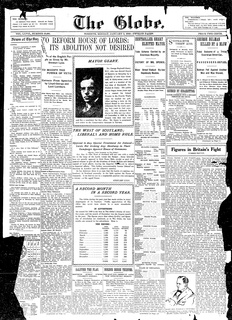Municipal elections were held in Toronto, Ontario, Canada, on January 1, 1932.
Municipal elections were held in Toronto, Ontario, Canada, on January 1, 1931. William James Stewart was elected mayor after winning a close contest again former mayor Sam McBride.
Municipal elections were held in Toronto, Ontario, Canada, on January 1, 1926. Thomas Foster was reelected mayor.
Municipal elections were held in Toronto, Ontario, Canada, on January 1, 1925. Thomas Foster was elected mayor ousting incumbent Wesley Hiltz. The election included a referendum where voters passed a motion in favour of building a new water plant. This eventually became the R. C. Harris Water Treatment Plant.
Municipal elections were held in Toronto, Ontario, Canada, on January 1, 1924. Wesley Hiltz was elected mayor defeating two prominent challengers.
Municipal elections were held in Toronto, Ontario, Canada, on January 1, 1923. Charles A. Maguire was reelected to his second term as mayor.
Municipal elections were held in Toronto, Ontario, Canada, on January 2, 1922. Incumbent mayor Tommy Church did not run for reelection. Charles A. Maguire was the only candidate who ran to succeed him and he was acclaimed.
Municipal elections were held in Toronto, Ontario, Canada, on January 1, 1921. Mayor Tommy Church was elected to an unprecedented seventh consecutive term in office.
Municipal elections were held in Toronto, Ontario, Canada, on January 1, 1920. Mayor Tommy Church was elected to his sixth consecutive term in office. The most notable feature of the election was Constance Hamilton winning a seat in Ward 3. She became the first woman elected to as high a post in any government in Ontario.
Municipal elections were held in Toronto, Ontario, Canada, on January 1, 1919. Mayor Tommy Church was elected to his fifth consecutive term in office. This election marked the creation of Ward 8, covering the recently annexed areas of East Toronto. The representation of Ward 7 was also increased to have three alderman like every other ward.
Municipal elections were held in Toronto, Ontario, Canada, on January 1, 1918. Mayor Tommy Church was elected to his fourth consecutive term in office.
Municipal elections were held in Toronto, Ontario, Canada, on January 1, 1917. Mayor Tommy Church was acclaimed to his third consecutive term in office.
Municipal elections were held in Toronto, Ontario, Canada, on January 1, 1915. Tommy Church was elected mayor defeating Jesse O. McCarthy.
Municipal elections were held in Toronto, Ontario, Canada, on January 1, 1914. H.C. Hocken was reelected mayor defeating Fred McBrien. The election was also notable for the victory of Louis Singer, the first representative of Toronto's large Jewish community elected to city council.
Municipal elections were held in Toronto, Ontario, Canada, on January 1, 1913. H.C. Hocken was elected to his first full term as mayor.
Municipal elections were held in Toronto, Ontario, Canada, on January 1, 1912. Mayor George Reginald Geary faced no opponents and was acclaimed for reelection.
Municipal elections were held in Toronto, Ontario, Canada, on January 2, 1911. Mayor George Reginald Geary was easily reelected mayor.

Municipal elections were held in Toronto, Ontario, Canada, on 1 January 1910. George Reginald Geary was elected to his first term as mayor. Two plebiscites were passed:
- To build a tube and surface subway transit system;
- Election of Board of Education by wards.
Municipal elections were held in Toronto, Ontario, Canada, on January 1, 1909. Joseph Oliver was easily re-elected to his second term as mayor. One of the central issues of the campaign was whether the city should construct a bridge over the Don River connecting to Danforth Avenue. A referendum was held as part of the vote, and the bridge was approved. It would be built as the Prince Edward Viaduct.


